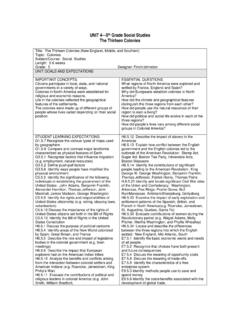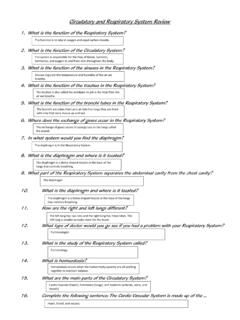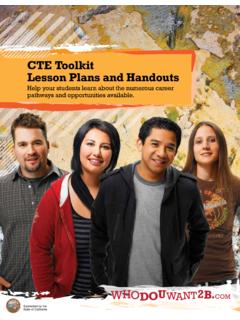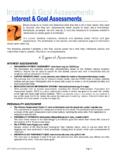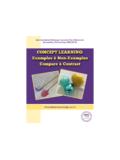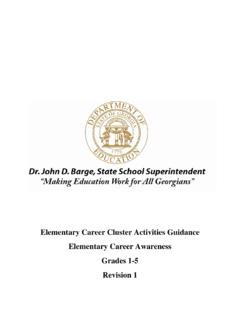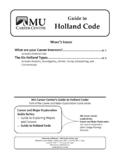Transcription of UNIT 3—5th Grade Social Studies Exploration
1 UNIT 3 5th grade social studies exploration Title: Other Countries Explore and Settle Subject/Course: Social Studies Length: 4-5 weeks Topic: Cooperation and Conflict Grade : 5 Designer: Finch/Johnston UNIT GOALS AND EXPECTATIONS. IMPORTANT CONCEPTS: ESSENTIAL QUESTIONS: in the Americas. What do you think the Europeans were looking for Primary sources provide historical information and when they began exploring the Americans? points of view. Technology had made ocean Exploration possible. Which country claimed the most land in America? Major European countries were in competition to extend their power in the Americans and claim the land as their own. European explorers in the 1400s were looking for a Why did Europeans not know that American blocked sea route to Asia. their route to the Pacific Ocean? In 1492, Columbus tried to reach Asia by sailing west across the Atlantic, but he reached the Americas instead.
2 Conquistadors explored and claimed much land for Spain. Missionaries came to the Americas to spread the Catholic religion. STUDENT LEARNING EXPECTATIONS: . Recognize the various types of maps used Examine the impact of early Exploration by geographers. and settlement patterns of the Spanish, Br4itish, and Understand the contributions of people of French in North America ( Roanoke, Jamestown, various racial, ethnic, and religious groups in St. Augustine, Quebec, Santa Fe). Arkansas and the United States. Explain how westward expansion Recognize examples of cultural diffusion, contributed to the growth of the United States ( cultural exchange, assimilation. Wilderness Road, Louisiana Purchase, Gadsden Recognize factors that influence migration Purchase). ( employment, natural resources) Identify and explain major pre-Colombian Define push-pull factors.
3 Civilizations in Central and South America ( Maya, Identify various forms of technology and Inca, Aztec). methods of transferring ideas and information. H Locate and describe the differences Identify the founding documents that helped between the three regions into which the English to establish laws for the United States ( settled New England, Mid-Atlantic, South. Mayflower Compact..) Recognize that choices have both present H Identify the contributions of significant and future consequences. individuals and explorers during the period of early Discuss the meaning of opportunity costs. European Exploration of the Americas ( E Examine the economic decisions that every Christopher Columbus, Ferdinand Magellan, society must make: what is to be produced and in Hernando de Soto) what quantities, how will it be produced , who will H Identify areas of the New World colonized receive what is produced by Spain, Great Britain, and France.
4 Identify the four basic categories of earned the role and impact of legislative income that are received from the four factors of bodies in the colonial government ( town production wages and salaries, rent, interest, profit. meetings) E Discuss the purpose of selling stocks to Analyze the benefits and conflicts arising capitalized companies ( joint-stock company). from the interaction between colonial settlers and E Identify the costs/benefits associated with American Indians ( Roanoke, Jamestown, King the development of global trade. Philip's War) E Identify various types of currency in the H Evaluate the contributions of political and global economy religious leaders in colonial America ( John E Identify how changes in supply and Smith, William Bradford, Roger Williams, Anne demand affect prices. Hutchison, John Winthrop, Thomas Hooker, William Penn).
5 Describe the impact of slavery in the Americas ( indentured servants, American Indians, African Americans.). H Explain the religious, political, and economic reasons for movement of people and goods from Europe to the Americas, Columbian Exchange, Triangular Trade SPECIFIC DECLARATIVE KNOWLEDGE SPECIFIC PROCEDURAL KNOWLEDGE. Jamestown marked the beginning of England's Interpret and use information given on an elevation colonies in the Americas. map. Tobacco profits helped the colony grow and led to Trace on maps the routes of major explorers of the the use of enslaved African workers and to the United States and identify the areas they claimed. Powhatan Wars. Describe the cooperation and conflict between Locate the lands in North America claimed by Spain. settlers and Native Americans. Identify why Europeans began to look for a sea Analyze the differences between primary and route to Asia.
6 Secondary sources in historical and modern List things that Europeans found when they explored contexts. America. Complete graphic organizers, word webs, etc. Give reasons why the Spanish explored and identifying the different explorers. conquered large areas of the Americas. Summarize each chapter using the important events List all Explorers who explored the Americas and the Analyze historical people, places, events, and ideas things they found. in graphic formats. Identify reasons Spain set up colonies in North Analyze visuals while reading America Work in pairs to determine the main idea and details Identify reasons why the English settlers came to in specific section of text. North America, and list the places they settled first. In small groups students will plan a business for the Reasons for the English settling in New England community Identify vocabulary terms and there meaning Group work throughout the text.
7 Research Columbus' other voyages after reaching Identify character traits of Columbus, Bartolome de America Las Casas, Estavancio, Francisco Vasquez de Analyze the technology innovation that made sea Coronado, John Smith, Squanto, William Bradford, Exploration possible (compass, astrolabe, map, and and Pcohantas). chronometer). Identify specific dates on a time line Complete a variety of writing assignments Maps/Illustrations Locate places and routes on maps Identify Main Ideas and Supporting details Describe the aims, obstacles, and accomplishments Organize information in a checklist of the early explorers Add new information to background knowledge Scan certain sections to find the meaning of School of navigation in Portugal and new technology vocabulary terms allowed Europeans to explore new lands. Read different Points-of-View concerning Learn how to turn headings into questions Christopher Columbus's Voyages Compare/Contrast Cause/Effect Trace routes on a map Focus on related words ex: reform, reformation, counter-reformation UNIT ASSESSMENTS.
8 (Include tasks related to Dimensions 3 and 4 and Bloom's Taxonomy). Unit Project: A Museum of Exploration - Build a museum exhibit about the Exploration and early colonization of North America. Decide which places, people, and events to include in the museum. Prepare brief journal reports, journal entries, drawings, maps, and models for the museum. Pg. 91N-97O in teachers manual D-B-Q Document-Based Question-Navigational Tools Pg. 118-119. Unit Assessment covering both chapters 3 and 4. Design a stamp or coin that honors and important person, place, or event related to the European Exploration and colonization of the Americas. Traditional Assessments: Other Evidence of Learning: Vocab quizzes Daily mini lessons Homework Writing Assignments Assignments Chapter review Lesson review Chapter test Maps Unit Test Graphic Organizers Writing assignments Routes ACTIVITIES AND LEARNING EXPERIENCES Resources Cultures Meet The United States: Introduce Unit Making a New Nation, Preview time Harcourt Preview people Preview place Discuss the map and illustrations Homework and Practice Start with a Journal- The log of Christopher Columbus -pg 104-107 Book, Harcourt Reading Social Studies Main Idea and Details Chapter 3.
9 The Age of Exploration . Introduce the Chapter Study skills Using visuals Historical people, places, events and ideas in graphic organizers Preview vocabulary Lesson 1. Preview Vocabulary Assess prior knowledge Express Path-Quick Summary pg. 110. Link History and Culture Look at the illustration of the caravel: Define caravel and then use as a springboard to discuss the main events in the section Discuss Main Idea and Details Plan a small business for the community in small groups Pg. 114. Review Questions Navigational Tools-Ling to the Big Idea Lesson 2. Preview Vocabulary Express Path-Quick summary of lesson Compare the voyages of Columbus and Cabot Use map on pg. 124 to describe Magellan's voyage around the world Review questions Make a table of Explorers Lesson 3. Review points of view Preview Vocabulary Have class scan the selection to find the meaning of the words in bold.
10 Choose a paragraph on pg 130-131 and have students get into pairs to read the paragraph and identify the main idea and supporting details. Review background Seven Cities of Gold . Have students read the summary at the end of the lesson and re-state the lesson's key content. Review questions Write a journal entry Biography of Estevanico Lesson 4. Review elevation maps pg. 136-137. Preview vocabulary Build background knowledge Illustration-have students speculate about the location of the ship in the picture on pg 139. List all locations of Cartier's expeditions on pg. 140-141. Divide class into 5 groups: have each group read one paragraph and summarize what the group learned. Review questions Writing: Pick a European explorer and write a scene about their contact with Native Americans. Students use Visual Summary on pg.
